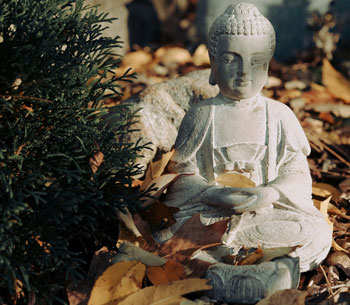by Philip Jones

When I first began practicing Insight Meditation, I was told to sit still and give my com-plete attention to my breath. And when my mind wandered (which was most of the time) and I noticed it (not so often), I should bring my attention back to the breath without crit-icism (that was a challenge). I should do this again and again and again and again. I was told that eventually my mind would settle down (it did!… sometimes), that this practice would get easier (it was … sometimes), and that all of this was part of becoming mindful.
In time I learned that there were other things to give my meditative attention to, other ways to cultivate and apply mindfulness. An implication was that mindfulness of breathing was a good place to start but, really, it was only an introductory practice.
Perhaps this is the way it was for you also?
But, the Buddha is recorded as having said
Being cultivated and made much of, meditation on mindfulness of breathing is peaceful, sublime, and immaculate, it is a happy abiding that allays and quells bad and unwholesome mental states as soon as they arise. — SN 54.9 (Bhikkhu Anālayo, trans.).1
If this sounds like the Buddha was talking about a different kind of mindfulness of breathing, it’s because he was. In the Discourse on Mindfulness of Breathing In and Breathing Out (Ānāpānasati-sutta, MN 118) the Buddha offered sixteen concise steps, or instructions, that can indeed lead to the profound experiences he describes above.
The Buddha’s concise instructions for mindfulness of breathing in this sutta have been understood and practiced in a variety ways over the past 2500 years. For instance:
- The first four instructions were extracted from their context in the Ānāpānasati-sutta and eventually reduced to the practice I described at the beginning.
- The sixteen practices have been used for the development of focused mindful attention leading to deep states of meditative concentration (absorptions or the jhānas). Sometimes this has been done prior to any insight practice, sometimes with insight practice following, sometimes without any emphasis on insight practice.
- I learned from Bhikkhu Anālayo that these sixteen practices also have the potential to cultivate both focused mindful attention and open receptive mindfulness leading to the development, hand in hand, of tranquility, insight, and the awakening factors.
In this third approach, mindfulness of breathing in and breathing out supports us as we train in cultivating a natural and progressive development of tranquility (calmness) of body and of mental activities (especially thoughts). This can lead to experiences of joy and happiness, and to the profound still and clear experience of the mind itself temporarily freed of distractions. Sometimes this can also naturally lead to the mind collecting and unifying in deep concentration.
At the same time, also supported by mindfulness of breathing in and breathing out, insight can arise into the conditions necessary for the natural progression from one step to the next and for the arousal of the awakening factors. The balanced and purified mind-state that has been developed in these ways can then be applied to seeing the way things are, particularly their impermanence, and to the process of letting go. In this way our minds and hearts become increasingly inclined towards awakening.
This third approach will be offered in Mid America Dharma’s residential retreat “Cultivating Tranquility, Insight, and the Awakening Factors” with Philip Jones , Aug. 14-22 at Conception Abbey, Conception, MO. Registration for the retreat will open April 30.
I hope you’ll explore these practices with me and experience the possibilities for yourself.
1. Bhikkhu Anālayo, Mindfulness of Breathing: A Practice Guide, Cambridge, UK: Wind-horse Publications, 2019, p. xvi.
Philip Jones has practiced Insight Meditation since 1992 and began teaching in 1996. He graduated from the first Spirit Rock Community Dharma Leader program in 2000. He has studied with Matt Flickstein, Bhikku Analayo, Shaila Catherine and Ann Dillon.